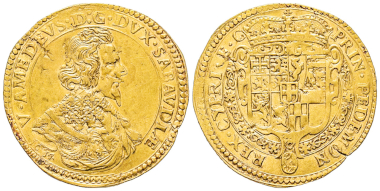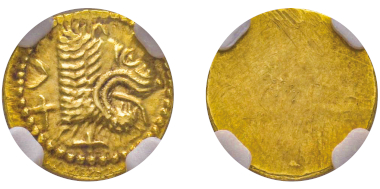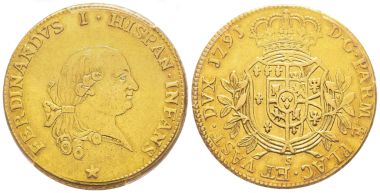15-11-2018 – 16-11-2018
Vente Publique
Impressive Collection “Casa Savoia” from the Property of a Gentleman of the Royal Family
The 2018 auction put together by Éditions Victor Gadoury is a very special one indeed. It encompasses a large variety of showpieces ranging from antiquity to the modern period. The extraordinary series of Roman gold coins in particular contains some items with an attractive estimate that will surely allure bidders to Monaco, which, by the way, still has gorgeous weather to offer in November. And just in case yet another argument is needed: the traditional “Grande Bourse”, an international convention offering stamps, coins, and postcards, will take place on Sunday, November 18, 2018.
No. 1745 – A coin with a handwritten note stating that the collector received it as a gift from King Victor Emmanuel III, who was a famous coin collector himself. Estimate: 1,000 euros.
The highlight of this Gadoury Auction is no doubt the collection of Casa Savoia coins featuring a total of 350 lots. The Casa Savoia had ruled over Savoy and Piedmont since the High Middle Ages and held the position of King of Italy from 1861 until 1946. This is not just spectacular material. All of these coins can also attest to an impressive pedigree.
Casa Savoia – A Collection from the Property of a Gentleman of the Royal Family
So let’s begin with this unique collection. The time span covered ranges from a coin of Humbert II (1080-1103), the great-grandson of the dynasty’s founder, to the coins, medals, and decorations from the time of the reign of Victor Emmanuel III. In this preview, we will present five selected specimens. They represent a rich variety of great rarities. Needless to say, not all of these lots are estimated at four- or five-digit figures. Some rare and unusually well-preserved fractions are available at an estimate of only 50 euros.
No. 1460 – Charles I, 1482-1490. Ducato d’oro, type II, Turin. From The Stack Collection of Italian Renaissance Coins. Unedited. Probably unique. Extremely fine. Estimate: 50,000 euros.
At the end of the 15th century, Charles I (1482-1490) had gold ducats minted in Turin, which depicted his portrait, as it was the fashionable thing to do at the time. He thus provided us with the first portrait of a member of the Casa Savoia on a coin. The image of a very young man we see here agrees with reality: Charles became Duke of Savoy at the age of 14 and died shortly before his 22nd birthday, just after barely having successfully fathered an heir to the throne.
No. 1505 – Charles Emmanuel I, 1580-1630. 10 scudi d’oro, type II, Turin, 1610. Only three specimens known! NGC MS60. Estimate: 200,000 euros.
Only three specimens are known of a heavy gold coin worth 10 scudi, which was made in Turin in 1610. It was Charles Emmanuel I, who is known by each resident of French-speaking Switzerland, who commissioned the production of this coin. In 1602, he failed to successfully complete the famous L’Escalade, a failure which is still celebrated in Geneva to this day.
No. 1527 – Victor Amadeus I, 1630-1637. Quadrupla, type III, Turin, 1634. Extremely rare. Very fine + / Extremely fine. Estimate: 50,000 euros.
An extremely rare quadrupla was minted in Turin in 1634 by order of Victor Amadeus I. If you look at the reverse inscription carefully, you can tell that the duke refers to himself as king here. Since 1632, he had professed a claim to the title of King of Cyprus and Jerusalem.
No. 1590 – Charles Emmanuel III, second period 1755-1773. Carlino da 5 doppie, Turin, 1755. Very rare. NGC AU58. Estimate: 40,000 euros.
In this auction, Gadoury manages to offer both the full carlino da 5 doppie as well as the half carlino da 2.5 doppie with the portrait of Carles Emmanuel III which were struck in Turin in 1755 resp. 1757. On this coin Charles referred to himself as King of Sardinia in addition to all of the titles already known. His father had taken control of this island. Savoy had turned the scales in the wars of Louis XIV and had emerged victorious from these military conflicts: the territorial gain and a promotion to a higher position within the aristocracy vaulted the Casa Savoia to the ranks of the European Central Powers.
No. 1759 – Victor Emmanuel III, 1900-1943. Essay for 100 lire, Rome, 1910. Extremely rare. NGC PROOF 66. Estimate: 150,000 euros.
The essay for the 100 lire coin from 1910 surely belongs to the rarest coins of the last king of the Casa Savoia king. It depicts a type of bust and reverse which was then carried over to the design of circulation coins. Victor Emmanuel is shown as a general in spare uniform. The reverse shows Italia ploughing the ground.
An original case, which was offered as an award for the improvement of agricultural methods, contains all of the gold coins with this motif from 1912 (10, 20, 50, and 100 lire). It will be offered as the following lot.
No. 2 – Populonia (Etruria). 25 litra, 350-300. NGC MS 5/5-4/5. Estimate: 4,000 euros.
Greek and Celtic Coins
And so, we return to the beginning of the auction, which will commence on November 16 at 2:00 pm. That leaves enough time to look at the most important lots in the morning.
First off, a small batch of Greek and Celtic coins will be sold, most of which are made of gold. One extremely rare piece is a 25 litra coin minted in the Etruscan town of Populonia between 350 and 300 BC.
No. 92 – Plotina, 105-122. Aureus, 112-115. Very rare. NGC AU 5/5 – 3/5. Estimate: 20,000 euros.
The Crème de la Crème of Roman Gold
Lot 30 heralds the start of the Roman coins section. The large number of perfectly preserved aurei and solidi, including some rare coins with interesting reverse images of infrequently seen emperors and their relatives, is especially remarkable. Many of them have been graded by NGC.
One example is the very rare aureus emperor Trajan had minted on behalf of his wife Plotina. This empress would go down in history. She made it possible for Hadrian to ascend the throne.
No. 97 – Hadrian, 117-138. Aureus, 119-122. Very rare. NGC VF* 5/5 – 5/5 Fine Style. Estimate: 9,000 euros.
Hadrian is also represented in this auction, namely in one of his aurei with an extremely rare reverse that alludes to the happy time which began when Hadrian assumed his reign. One can see SAEC[VLVM] AVR[EVM] (= the Golden Age) written underneath the depiction of the emperor. He holds a globe in his right hand with a phoenix sat on top of it. He is surrounded by the serpent Ouroboros eating its own tail and thus representing eternity.
No. 176 – Diocletian, 284-305. Aureus, Cyzicus, 284-305. Very rare. NGC MS 5/5 – 2/5 graffito. Estimate: 10,000 euros.
Whether it is a perfect aureus marking the death of Antonius Pius, which possibly is the most beautiful specimen we know of today (no. 134; estimate: 18,000 euros.), whether it is an aureus of Commodus with a rare reverse depicting Mars shouldering a trophy (no. 141; estimate: 25,000 euros), whether it is an aureus of Trajanus Decius, speaking of prosperity in times of poverty and depicting Uberitas (no. 169; estimate: 12,000 euros), whether it is an aureus of Diocletian with an extremely rare reverse image of the three victorious Fates, which was struck after Diocletian had divided his power and designated Maximian as co-emperor (no. 176; estimate: 10,000 euros), whatever you are looking for, the Gadoury auction offers an abundantly rich selection.
No. 360 – Majorian, 457-461. Solidus, Mediolanum, 457-468. Very rare. Very fine. Estimate: 8,000 euros.
The selection of gold coins of the final phase of the Western Roman Empire is particularly impressive. Many emperors who are rarely offered at auctions are represented with a solidus in this one: For example, Majorian (no. 360; estimate: 8,000 euros), Libius Severus (no. 361; estimate: 6,000 euros), Ricimer in the name of Leo I (no. 363; estimate: 4,000 euros), and Anthemius (no. 379; estimate: 5,000 euros).
No. 402 – Merovingian coins. Solidus, Marseille. In the name of Mauritius Tiberius. From Münzen und Medaillen AG Auction 81 (1995), no. 956. Very rare. Very fine +. Estimate: 7,000 euros.
Rarities of the Early Middle Ages
Within this sale coins from the Early Middle Ages are represented in abundance. We encounter coins of the invaders of the Western Roman Empire such as Odoacer and Theoderic.
And all those who collect Merovingian coins should also pay close attention. Coins and medals of the towns of Marseille and Banassac are featured numerously. Although everyone still knows Marseille today, only a few are aware that the small commune of Bannasac in Southern France with a population of 800 used to be a Merovingian center.
No. 463 – Lombard coins. Tremissis, Pistoia, 8th century. Unpublished. Extremely fine. Estimate: 8,000 euros.
45 lots of Byzantine coins and 8 Lombard coins bring this Early Middle Ages section to a close. An unpublished 8th century tremissis should be acknowledged, which was minted in Pistoia. Its exceptional quality would be reason enough for this to become the attraction of a Lombard collection.
No. 468 – Monaco. Louis I, 1662-1701. 1/2 écu ( = 30 sols), 1663. Unpublished. Very fine +. Estimate: 30,000 euros.
Monaco
As always, Gadoury can offer an extensive selection of coins from Monaco. The most important coin is an unpublished half écu ( = 30 sols) of Louis I from 1663, a year after he had succeeded to the title of Prince of Monaco. Louis I gained international political importance when the French King Louis XIV made him a Pair de France, i.e. a member of French high aristocracy, in 1668.
No. 656 – Columbia. Gold medal 1904 minted by the Republic of Columbia for Lucien Napoléon Bonaparte Wyse, son of the niece of Napoléon I (1844-1909). Extremely rare. NGC MS62. Estimate: 10,000 euros.
World Rarities
Of course, gold coins are not the only items offered at Gadoury but gold predominates! There are some unbelievable rarities of greatest historical importance to be found in the catalog. For example, a gold medal, which was struck on behalf of the Republic of Columbia to be given to Lucien Napoléon Bonaparte Wyse.
The great-nephew of Napoleon I obtained the permission to build and operate the Panama Canal. After efforts of the French had failed and the United States attempted to seize the project, Bonaparte Wyse wrote an open letter to Roosevelt in order to make the American public aware of the criminal actions of its government. Roosevelt answered with a military intervention which led to the establishment of the Republic of Panama. And thus the Canal could be built by the Americans. Columbia expressed its gratitude for the support of Bonaparte Wyse in form of a gold medal, precisely the one, which is sold at this Gadoury auction.
And this is just one of many examples. From Albania to Zaire – there really is something to be found for every collector. In this preview, we will mention only those sections which are represented in the catalog in extensive series.
No. 572 – Austria. Franz Joseph, 1848-1916. Medal worth 100 ducats by Konrad Lange. FDC. Estimate: 20,000 euros.
Austria (lot 557 – lot 628): The 19th and 20th century are featured in large numbers.
No. 766 – France. Louis XV, 1715-1774. Essay for the gold écu au bandeau. Paris, 1740. Extremely rare. 4 specimens graded. PCGS SP62. Estimate: 80,000 euros.
France (lot 721 – lot 1025): The range of coinages covers a time from the Carolingians to modern-day coins and medals. As usual, Gadoury offers numerous essays and piedforts.
No. 1166 – Mantua. Francesco II Gonzaga, 1484-1519. Ducato, 1484-1495. Extremely rare. FDC. Estimate: 30,000 euros.
No. 1200 – Naples. Gold medal, Naples 1813. Minted in celebration of the return of Joachim Murat from the Russian Campaign. Designed by Antonio Canova(?). Julius Collection (this specimen). Unique. Small edge nick, otherwise FDC. Estimate: 50,000 euros.
No. 1210 – Parma. Ferdinando di Borbone, 1765-1802. 8 doppie, 1791. Extremely rare. PCGS AU50. Estimate: 20,000 euros.
Italy (lot 1103 – lot 1433): Many coinages from the Napoleonic era are featured in this auction, as well as an extensive selection of coins and medals from the Papal States including great rarities, but also attractively estimated lots starting at 50 euros.
No. 1425 – Venice. Francesco Corner, 1656. Sequin. Extremely rare. PCGS MS62 (the most beautiful graded specimen). Estimate: 25,000 euros.
A selection of coins from Venice, including several great rarities, will also be auctioned off in the Italy section.
No. 1883 – Russia. Medal in celebration of the coronation of Nicholas II and Alexandra Feodorovna 1896. Four different sizes of this medal exist, this specimen equates to the biggest size. Extremely rare. FDC. Estimate: 35,000 euros.
Russia (lot 1857 – lot 1889).
No. 1906 – Czechoslovakia. 10 ducats 1929. Only 1,564 specimens struck. PCGS MS66. The best graded specimen. Estimate: 15,000 euros.
Czechoslovakia (lot 1906 – lot 1920): The focus of this selection is on the great rarities from the time before the German annexation.
No. 1970 – USA. 10 dollars, New Orleans, 1883. Only 800 specimens struck. Extremely rare (only 40 to 50 known exemplars). PCGS AU53. Estimate: 15,000 euros.
USA (lot 1928 – lot 2003): The connoisseur will find numerous rarities, both graded and ungraded.
You can order the catalog at Éditions Victor Gadoury, 57, rue Grimaldi, 98000 Monaco; phone: +377 93 25 12 96; fax: +377 93 50 13 39; e-mail.
You will also find them online at the Gadoury website, on Sixbid (Part 1 and Part 2), Numisbids, Bidinside (Part 1 and Part 2), Drouot Live (Part 1 and Part 2), and Biddr.



























